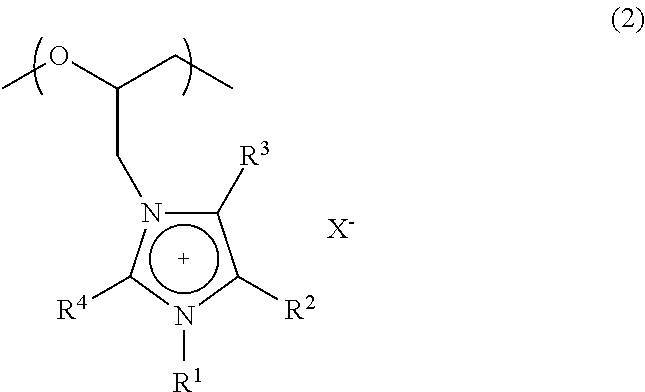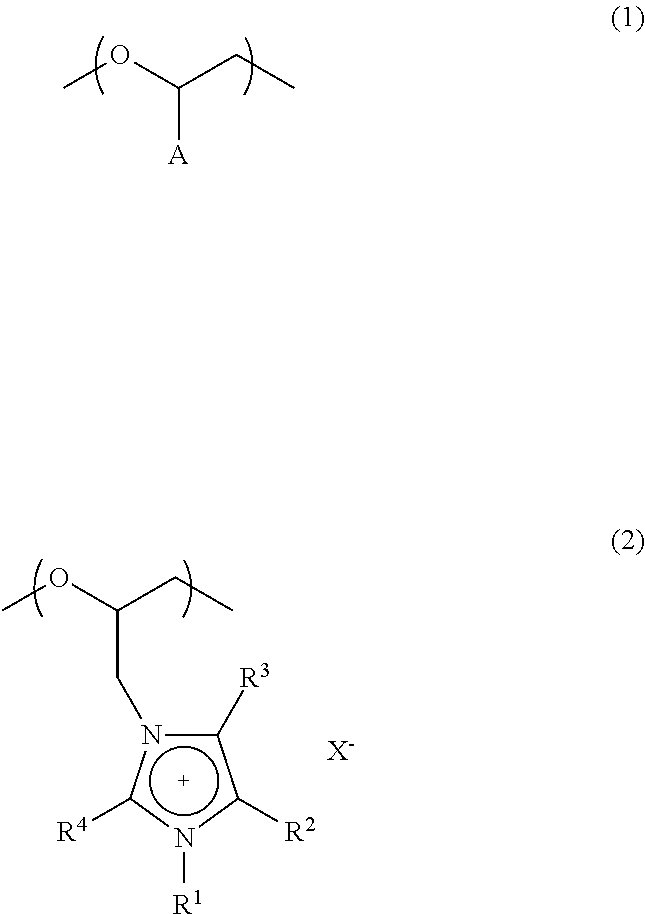Polyether compound and electrolyte composition
a technology of polyether compound and electrolyte composition, which is applied in the direction of conductive materials, organic chemistry, conductors, etc., can solve the problems of reduced liquid amount along with time due to evaporation of solvent or liquid leakage, prone to liquid leakage, and difficulty in handling, etc., to achieve excellent ion conductivity, convenient handling, and suitable fluidity
- Summary
- Abstract
- Description
- Claims
- Application Information
AI Technical Summary
Benefits of technology
Problems solved by technology
Method used
Image
Examples
examples
[0059]Below, examples and comparative examples will be given to more specifically explain the present invention. Note that, the “parts” and “%” in the examples are based on weight unless otherwise indicated.
[0060]The various measurements were performed based on the following methods.
[0061][Number Average Molecular Weight (Mn) and Molecular Weight Distribution (Mw / Mn)]
[0062]Gel permeation chromatography (GPC) using dimethylformamide as a solvent was used for measurement as a value converted to polystyrene. Note that, as the measuring device, HLC-8320 (made by Toso) was used. As the column, two TSKgelα-M (made by Toso) were used connected in series. For the detector, a differential refractometer RI-8320 (made by Toso) was used.
[0063][Volume Specific Resistance Value]
[0064]For the sample coin shaped cell, as a measuring system, an Impedance Analyzer Model 1260 and Potentiostat Model 1287 (both made by Solartron) were combined for use to measure the volume specific resistance value. Not...
production example a
[0065](Living Anion Polymerization of Epichlorohydrin)
[0066]To a glass reactor equipped with a stirrer and with an inside substituted by argon, tetranormal butylammonium bromide 3.22 g and toluene 50 ml were added. This was cooled to 0° C. Next, triethyl aluminum 1.256 g (1.1 equivalents with respect to tetranormal butylammonium bromide) dissolved in normal hexane 10 ml was added. This was reacted for 15 minutes to obtain a catalyst composition. To the obtained catalyst composition, epichlorohydrin 10.0 g was added. The polymerization reaction was performed at 0° C. After the start of the polymerization reaction, the viscosity of the solution gradually rose. After 12 hours reaction, a small amount of water was poured into the polymerization reaction solution to stop the reaction. The obtained polymerization reaction solution was washed by 0.1N hydrochloric acid aqueous solution to remove the catalyst residue. Furthermore, this was washed by ion exchanged water, then the organic phas...
production example b
[0067](Quaternization of Epichlorohydrin Oligomer by 1-Methylimidazole)
[0068]The epichlorohydrin oligomer which was obtained in Production Example A, 5.0 g, 1-methylimidazole 12.1 g, and acetonitrile 10.0 g were added to a glass reactor equipped with a stirrer substituted with argon and heated to 80° C. After reaction at 80° C. for 48 hours, the solution was cooled to room temperature to stop the reaction. The obtained reaction product was washed by an equal weight mixed solvent of toluene / methanol / water, then the organic phase including 1-methylimidazole and toluene was removed and the aqueous phase was dried in vacuo at 50° C. for 12 hours, whereupon a light reddish solid 9.4 g was obtained. This solid was measured by 1H-NMR and elementary analysis, whereupon it was identified as an imidazolium structure-containing polyether compound which has halide ions as counter anions wherein all of the chloro groups of the repeating units of the starting material epichlorohydrin oligomer wer...
PUM
| Property | Measurement | Unit |
|---|---|---|
| temperature | aaaaa | aaaaa |
| temperature | aaaaa | aaaaa |
| temperature | aaaaa | aaaaa |
Abstract
Description
Claims
Application Information
 Login to View More
Login to View More - R&D
- Intellectual Property
- Life Sciences
- Materials
- Tech Scout
- Unparalleled Data Quality
- Higher Quality Content
- 60% Fewer Hallucinations
Browse by: Latest US Patents, China's latest patents, Technical Efficacy Thesaurus, Application Domain, Technology Topic, Popular Technical Reports.
© 2025 PatSnap. All rights reserved.Legal|Privacy policy|Modern Slavery Act Transparency Statement|Sitemap|About US| Contact US: help@patsnap.com



